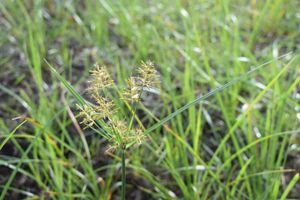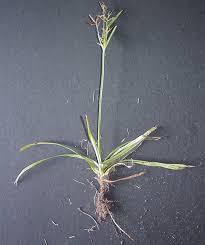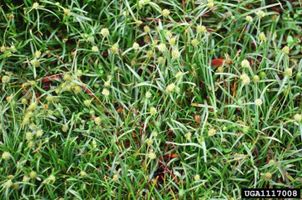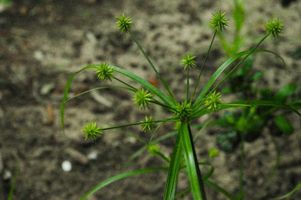What are the different types of Nutsedge and do I have this in my lawn?

Sedges are annual or mostly perennial grass-like plants with aerial flower-bearing stems. In annual forms, the stem is solitary to mostly several with basal leaves. Perennial forms have a thick rootstock or an erect to horizontal underground rhizome (rhizome – a continuously growing horizontal underground stem which puts out lateral shoots and adventitous roots at intervals) usually with shortened internodes.
Sedges usually have triangular stems with leaves arranged in groups of three and are similar to grasses in many attributes. Sedge species may be found in a wide range of conditions, ranging from very wet to dry and in many soil types.
In sedges, as well as grasses, the seed head will be produced at the end of an aerial, erect stem. This three-sided stem is usually solitary and will be tufted with basal leaves. Root systems are fibrous, including species such as yellow and purple nutsedge which produce rhizomes and tubers. Flowers are extremely small and numerous and arranged in spikelets atop the stem.
Sedges are of little economic value to man but can be very competitive with the desired crop for water, nutrients and space.
Yellow Nut Sedge
- Season: rapidly spreading, aggressive, erect perennial
- Stem: slender, smooth, pithy and 3-angled (triangular in cross section), arising from rhizomes, tubers or basal bulbs
- Height: up to 24 inches tall
- Roots: fibrous, branched, with tubers or rhizomes
- Leafblade: yellowish green, prominent midvein, flat or slightly corrugated, 0.2 to 0.5 inch wide, waxy or shiny appearance, 3-ranked and growing from basal bulb, leaves usually as long or longer flowering stem, blade tapering to long thin tip
- Seed head: short, subtending leaf-like bracts, flattened, yellowish-brown spikelets, clustered around the ends of a few to 10 branches of unequal length
- Propagated by: seeds, creeping rootstock (rhizomes), or small underground nutlets. Nutlets (tubers) are brown, round, lack hairs, 0.5 to 0.75 inch long and may lie dormant in soil several years. Nutlets are individually produced and sweet or neutral to taste.
- Comments: prefers moist to dry cultivated soils and does not tolerate shade

Purple Nut Sedge
- Season: rapidly spreading, aggressive, erect perennial
- Stem: erect, smooth, solid, triangular in cross section, arising from tuber or basal bulb, and usually longer than leaves
- Height: up to 1.5 feet high
- Roots: extensively branched, fibrous, with tubers on rhizomes
- Leaf blade: deep-green, originates from the base of the plant, 3-ranked and grass-like, flat or slightly corrugated, prominent mid vein, 1/8 to 1/3 inch wide, and abruptly tapering to sharp point. Leaf is dark green smooth, shiny and usually shorter than stem.
- Seed head: short subtending leaf-like bracts, numerous flattened, red to purple brown spikelets clustered at the end of the stalk on a few to several branches
- Propagated by: slender creeping rootstocks (rhizomes) and nutlets (tubers). Nutlets are covered with hairs and are bitter to the taste. Multiple nutlets are produced forming a tuber chain.
- Comments: thrives in moist shady soils but does not tolerate shade, often thought to be the world’s worst weed

Green Kyllinga
- Season: mat-forming perennial
- Stem: dark green, arising from purple rhizomes, with 3 subtending leaves on the end of the flower stalk
- Height: up to 18 inches tall, frequently about 6 inches tall
- Roots: fibrous
- Leaf blade: dark green, 1 to 5 inches long and narrow
- Flower stalk: triangular in cross section
- Seed head: subtended by a few leaf-like bracts, usually one, occasionally 2 or 3 heads, initially pale green and often turning brown at maturity, globe-shaped and ¼ inch in diameter
- Seed: oval, flat in cross section (1/16 inch long)
- Propagated by: seeds and rhizomes
- Comments: found in low areas where moisture is excessive, can form large mats

Globe Sedge
- Season: perennial
- Stem: densley tufted
- Height: up to 20 inches tall
- Roots: fibrous, may form short rhizomes
- Leaf blade: bright green, flat, smooth
- Seed head: with 3-7 leaf-like bracts at top of stem, few to several branches of tight globular clustered spiklets, green and turning brown to black at maturity
- Propagated by: seeds and very short rhizomes
- Comments: grass-like, occurs in dry to moist sandy habitats, extremely common

These are just a few examples of Nutsedge.
Proper Management
The first and best method of weed control begins with proper management practices that encourage a dense, thriving turf. Healthy turf shades the soil so sunlight can’t reach weed seeds ready to germinate. A thick turf also minimizes the physical space available for weeds to become established. Several management practices promote a healthy, dense grass and help reduce the cost of weed control while maintaining the aesthetics of the lawn.
Proper Cultural Practices
Proper fertilization, watering, mowing, and pest control are required to produce a dense turf that can prevent weed infestation. If turf is over – or underwatered, over – or underfertilized, or mowed too low or too infrequently, the turf is weakened and the weeds move in. Sharpening the mower blades can reduce turf damage and the chances for weed invasion. It is very important and the chances for weed invasion. It is important to understand that weeds don’t create a void; they fill a void.
Traffic Control
Turf damaged by foot or vehicle traffic invites weeds. Turf growing in soil compacted by excessive traffic, especially when the soil is saturated with water, cannot develop a healthy root system as well as it can under noncompacted soil conditions. Goosegrass, annual bluegrass, dollarweed, and certain sedges grow well in compacted and/or continuously wet soil. The first step to managing weeds in such a situation is to alleviate soil compaction and/or saturated condition.
Pest Control
Pest damage makes the turf more susceptible to weed infestations by creating spaces for weed establishment and reducing the turf’s competitive ability. Specifically, tunneling from mole crickets disrupts the soil surface, enabling weed seeds to readily germinate. Other insects and diseases can cause areas of turf to become bare. These open areas are usually slow to recover and enable weeds to become established and grow quickly. High nematode populations also thin the turf and make it less able to recuperate from environmental stresses. Weeds that often become established in nematode-infested soil include spotted spurge and Florida pusley.
Sanitation
It is extremely important to prevent the introduction of weeds into lawn areas. If one can prevent weed establishment, control practices are not necessary. Areas adjacent to turf areas that are hard to mow, such as fence rows or ditch banks, often support a weed population. These weeds normally produce seed that infests the nearby turf. These areas should also receive weed management attention.
Another good practice is to wash off mowers and trimmers used in weed-infested areas before mowing or trimming in weed-free areas. Similarly, rototillers should be thoroughly cleaned prior to and after use to minimize weed seed dispersal in the soil. Yard clippings that contain weeds should be properly disposed of or composted to reduce the possibility of contamination. These sanitation practices are also important to prevent the introduction of other turfgrass species, which might reduce the purity and quality of the lawn.
If construction of renovation is planned, it is important to use weed-free soil. When planting, use only certified seed or weed-free sod to minimize weed spread. It is not unreasonable to request a tour of the sod farm where the sod will be purchased in order to inspect grass quality.
Weed Control Methods
As previously stated, it is essential to properly maintain turf to minimize weed invasion. If weeds become established, several methods of control are available.
- Mowing – Many annual weeds can be eliminated if proper mowing height and frequency are maintained. Mowing prior to weed seedhead formation also reduces weed seed reserves. Some weeds, however, readily establish below the desired mowing height. Management of these weeds requires additional control methods. As a rule of thumb, when mowing, remove only a third of the turf’s leaf blade at a time. This maintains a turf canopy that can grow vigorously while shading weeds and suppressing their growth.
- Hand Pulling or Rogueing – If only a few weeds are present, it’s simpler and less time-consuming to physically remove the plant, but if weeds are a major problem, other alternatives should be considered. When hand-pulling weeds, it is critical to remove the roots and underground parts to ensure the weeds will not survive and produce new shoots. Weeds such as Florida pusley might require the use of a small shovel to properly dig out the roots.
- Smothering – Smothering with nonliving material to exclude light is effective in certain areas, such as flower beds, foot paths, or nurseries, where turf is not grown. Materials used for this include mulch, leaves, rocks, and plastic film. To be effective, a minimize the risk of desirable plant roots encountering these layers.
- Herbicides – An herbicide is any chemical that injures or kills a plant. Herbicides are safe and effective if product label instructions are followed. Label instructions include proper application timing rates, and application methods. Herbicide application timing during the plant’s growth cycle is important. For example, weeds not controlled prior to seedhead formation are harder to control and are able to deposit new seeds in future. Herbicides are classified based on how and when they control weeds.
If you are experiencing weeds in your lawn and your not sure what kind or how to remedy the problem give GreenTec Pest Control at (727) 847-6733. We are here to help make your lawn picture perfect.
Remember our back to school specials.
Like and share us on Facebook
About the Business
Have a question? Ask the experts!
Send your question

